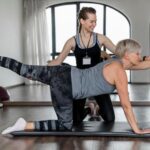Functional fitness has become a buzzword in the fitness world, but what exactly is a functional fitness workout? In simple terms, functional fitness focuses on exercises that mimic everyday movements to improve overall strength, flexibility, and endurance. This approach has gained popularity in recent years as more people are realizing the importance of not just looking fit, but being able to perform daily tasks with ease and efficiency.
The concept of functional fitness traces back to physical therapy and rehabilitation programs where exercises were designed to help individuals regain strength and movement after injuries. Over time, this idea evolved into a holistic training philosophy that emphasizes functional movements over isolated exercises. By incorporating movements like squats, deadlifts, and kettlebell swings into workouts, functional fitness enthusiasts aim to improve their performance in various activities both inside and outside the gym.
One of the key reasons why functional fitness has garnered a loyal following is its effectiveness in building practical strength and enhancing overall health. Unlike traditional bodybuilding or cardio routines that may focus solely on aesthetics or cardiovascular health, functional fitness workouts target multiple components of physical fitness such as agility, balance, coordination, and power.
As we delve deeper into the history and principles of functional fitness, it becomes evident why this approach has become so popular among athletes, gym-goers, and even everyday individuals looking to lead healthier lives.
History of Functional Fitness
Functional fitness has become a buzzword in the fitness industry, but what exactly is a functional fitness workout? Originating as a training philosophy that focuses on movements that mimic real-life activities, functional fitness has gained popularity in recent years due to its effectiveness in improving overall physical health and performance.
This type of exercise aims to enhance one’s ability to perform daily tasks with ease and reduce the risk of injuries by strengthening muscles, improving balance, flexibility, and coordination.
The history of functional fitness can be traced back to ancient Greece, where athletes would train using movements that mirror those required in sports or everyday life. However, it wasn’t until the late 20th century that functional fitness as we know it today began to take shape. Functional training gained traction in the 1990s when physical therapists and trainers started incorporating functional movements into rehabilitation programs for injured individuals to help them regain strength and mobility.
As the demand for more practical and efficient workouts grew, functional fitness evolved into a popular training method used by athletes, military personnel, and fitness enthusiasts. Today, this approach emphasizes natural human movement patterns like pushing, pulling, lifting, twisting, squatting, and lunging. By focusing on these fundamental movements rather than isolating specific muscles like traditional weightlifting routines do, functional fitness workouts offer a holistic approach to improving overall strength and endurance.
- Functional fitness emphasizes movements that mimic real-life activities
- Ancient Greek athletes trained using similar principles
- The modern concept of functional fitness gained popularity in the late 20th century
- This approach focuses on fundamental human movement patterns
- Functional fitness aims to improve overall strength and endurance
Principles of Functional Fitness
Functional fitness workouts are centered around the idea of training the body to perform everyday activities more efficiently and safely. These workouts focus on movements that mimic real-life tasks, such as bending, squatting, lifting, and reaching. The key principles that define a functional fitness workout include the emphasis on multi-joint movements, core stability, balance, flexibility, and coordination. These workouts also prioritize functional movements over isolated exercises to improve overall strength and mobility.
When it comes to intensity, functional fitness workouts can be tailored to suit individuals of all fitness levels. Beginners may start with bodyweight exercises and gradually increase the intensity by adding resistance or weight. Intermediate and advanced participants can incorporate more challenging movements like plyometrics or higher-intensity interval training (HIIT).
Variety is another essential aspect of functional fitness workouts to prevent plateaus and keep the body challenged. Mixing up exercises, equipment, reps, sets, and rest periods can help improve overall performance and prevent boredom.
A well-rounded functional fitness workout should include a combination of cardiovascular conditioning, strength training, flexibility work, and core stability exercises. This holistic approach not only enhances physical fitness but also improves mental focus and overall well-being.
By incorporating the principles of functional fitness into your workout routine, you can experience increased energy levels, better posture, enhanced muscle tone, improved endurance levels, and reduced risk of injury in daily activities. Investing time in understanding what is a functional fitness workout could lead to long-lasting health benefits for individuals of all ages and abilities.
| Key Principles | Definition |
|---|---|
| Multi-Joint Movements | Exercises that engage multiple joints in one movement to simulate real-life activities |
| Core Stability | Focusing on strengthening the muscles around the abdomen and lower back for better posture and injury prevention |
| Variety | Changing up exercises regularly to challenge different muscle groups and prevent training plateaus |
Benefits of Functional Fitness
Functional fitness exercises offer a wide range of physical, mental, and overall health benefits that make them a popular choice for individuals looking to improve their fitness levels. One of the key advantages of engaging in a functional fitness workout is the focus on everyday movements and activities. By incorporating exercises that mimic real-life movements like squatting, lifting, pushing, and pulling, functional fitness helps individuals improve their strength and performance in activities they do regularly.
Physical Benefits
One of the primary physical benefits of a functional fitness workout is improved strength and stability. Functional exercises target multiple muscle groups simultaneously, helping individuals develop a strong foundation for daily tasks and athletic performance. Additionally, functional fitness can enhance flexibility, agility, and balance, reducing the risk of injuries from falls or improper movement patterns. As individuals progress in their functional fitness training, they may also experience improvements in cardiovascular endurance and overall physical conditioning.
Mental Benefits
Engaging in a functional fitness workout can have numerous mental benefits as well. Physical activity releases endorphins, which are often referred to as “feel-good” hormones that can boost mood and reduce stress levels. The focus required during functional movements can also help individuals build concentration and mindfulness skills.
Furthermore, achieving personal goals in functional fitness training can increase confidence and self-esteem. Overall, regular participation in a functional fitness program can have positive effects on mental health and well-being.
Overall Health Benefits
In addition to the specific physical and mental benefits of functional fitness exercises, there are several overall health advantages as well. Regular exercise has been linked to improved cardiovascular health, reduced risk of chronic diseases such as diabetes and heart disease, and better weight management.
By engaging in a structured functional fitness routine that incorporates various movements at different intensities, individuals can support their overall health and longevity. The holistic approach of functional fitness towards improving strength, flexibility, endurance, balance, and coordination contributes to an individual’s overall well-being.
Common Functional Fitness Movements
Functional fitness workouts incorporate a variety of movements that mimic real-life activities and focus on functional strength, mobility, and endurance. These movements help improve overall physical fitness and performance in day-to-day tasks. Here are some common functional fitness movements that are frequently included in workout routines:
- Squats: Squats are a fundamental movement pattern in functional fitness workouts that target the lower body muscles, including the quadriceps, hamstrings, and glutes. Performing squats helps improve lower body strength, stability, and mobility.
- Deadlifts: Deadlifts are another essential movement in functional fitness training that primarily target the posterior chain muscles, such as the hamstrings, glutes, and lower back. Deadlifts help improve overall strength, posture, and lifting mechanics.
- Kettlebell Swings: Kettlebell swings are a dynamic exercise that engages multiple muscle groups simultaneously, including the core, shoulders, hips, and legs. This explosive movement improves power output, cardiovascular endurance, and coordination.
Incorporating these functional movements into your workout routine can help enhance your overall physical fitness and performance in various daily activities. By focusing on compound exercises like squats, deadlifts, and kettlebell swings, you can build functional strength and mobility that will carry over to your everyday life.
Remember to start with proper form and gradually increase intensity to avoid injury while performing these functional movements. If you’re new to functional fitness workouts or any of these specific exercises, consider working with a certified trainer to ensure you’re using correct technique and maximizing the benefits of each movement.
How to Get Started
Functional fitness workouts have become increasingly popular in recent years due to their focus on improving overall physical abilities for everyday activities. If you’re new to functional fitness and are looking to incorporate it into your workout routine, here are some practical tips and advice to help you get started on the right foot.
Set Clear Goals
Before diving into a functional fitness routine, take some time to identify your goals. Whether you’re looking to improve strength, flexibility, endurance, or overall fitness, having clear objectives in mind will help you tailor your workouts accordingly. Setting specific, measurable goals will also keep you motivated and track your progress along the way.
Start Slow and Gradually Increase Intensity
One of the key principles of a functional fitness workout is progression. It’s important to start at a pace that is suitable for your current fitness level and gradually increase the intensity over time. This approach not only reduces the risk of injury but also allows your body to adapt and develop strength in a safe and effective manner.
Focus on Proper Form
Proper form is essential when performing functional fitness movements to prevent injuries and maximize the effectiveness of each exercise. Take the time to learn the correct technique for each movement, whether it’s squats, deadlifts, or kettlebell swings. Consider working with a certified personal trainer to ensure that you’re executing each exercise safely and effectively. Remember, quality always trumps quantity when it comes to functional fitness workouts.
Functional Fitness Workouts for Different Goals
Functional fitness workouts can be tailored to suit a variety of different fitness goals, whether you are looking to build strength, lose weight, improve flexibility, or enhance endurance. Each goal requires a slightly different approach to functional fitness training in order to achieve optimal results. Here are some sample workout routines for each of these goals:
For strength training, focus on compound movements that engage multiple muscle groups at once. Include exercises such as squats, deadlifts, push-ups, and rows in your routine. Aim for lower repetitions with heavier weights to build muscle and increase overall strength. Incorporating resistance bands or kettlebells can also add variety and challenge to your strength training workouts.
If weight loss is your primary goal, consider incorporating high-intensity interval training (HIIT) into your functional fitness routine. Alternate between periods of intense exercise and rest to elevate your heart rate and burn calories more effectively. Include exercises like burpees, mountain climbers, and jump squats to maximize calorie burn during your workouts. Remember to also focus on maintaining a healthy diet alongside your exercise routine for optimal weight loss results.
Flexibility is crucial for overall health and injury prevention, so be sure to include stretching exercises in your functional fitness routine. Yoga poses like downward dog, pigeon pose, and triangle pose are excellent for improving flexibility and mobility. Incorporate dynamic stretches before your workout and static stretches after to enhance flexibility while reducing the risk of injury.
Endurance can be improved through aerobic exercises that elevate your heart rate over an extended period of time. Consider adding activities like running, cycling, or rowing into your functional fitness routine to boost cardiovascular endurance. Interval training can also be beneficial for improving endurance by alternating between periods of moderate intensity and higher intensity exercise.
By tailoring your functional fitness workouts to align with specific goals such as strength training, weight loss, flexibility, or endurance, you can optimize the effectiveness of your exercise routine and achieve desired results more efficiently. Experiment with different workout formats and listen to your body’s needs to create a balanced functional fitness regimen that works best for you.
Functional Fitness Equipment
Functional fitness workouts are gaining popularity among fitness enthusiasts due to their focus on movements that mimic real-life activities and help improve overall strength, balance, flexibility, and endurance. One of the key components of a functional fitness workout is the use of specific equipment that helps target different muscle groups and enhance the effectiveness of the exercises. When choosing equipment for a functional fitness routine, it is essential to consider your fitness goals, experience level, and budget.
Resistance bands are versatile pieces of equipment that can be used for various exercises targeting different muscle groups. They come in a range of resistances, making them suitable for individuals at any fitness level. Resistance bands can be used to add intensity to bodyweight exercises, such as squats or lunges, or to assist with stretching exercises to improve flexibility. They are also lightweight and portable, making them ideal for home workouts or when traveling.
Dumbbells are another essential component of a functional fitness workout as they allow for unilateral movements that help correct muscle imbalances and strengthen stabilizer muscles. Dumbbells come in different weights and can be used for a wide range of exercises such as overhead presses, rows, and lunges. They provide a challenging resistance that can be adjusted based on individual strength levels. Additionally, dumbbells are versatile equipment that can be utilized for full-body workouts targeting multiple muscle groups simultaneously.
Safety Tips
In conclusion, understanding what a functional fitness workout entails can greatly benefit individuals looking to improve their overall health and fitness levels. Functional fitness has gained popularity in recent years due to its focus on movements that mimic everyday activities, making it practical for daily life. By incorporating key principles such as variety, intensity, and functional movements into a workout routine, individuals can experience a wide range of physical, mental, and health benefits.
Engaging in functional fitness exercises not only improves strength, flexibility, and endurance but also enhances coordination, balance, and stability. By following safety tips such as maintaining proper form, warming up before a workout, and cooling down afterwards, individuals can prevent injuries and safely progress in their fitness journey. Whether one is a beginner or an experienced athlete, functional fitness offers a versatile approach to training that can be tailored to different goals such as strength training or weight loss.
To get started with a functional fitness workout, beginners can begin by incorporating common movements like squats, deadlifts, and kettlebell swings into their routine. By gradually increasing the intensity and variety of exercises while focusing on proper form and technique, individuals can maximize the benefits of functional fitness. With the right equipment such as resistance bands, dumbbells, and stability balls, anyone can enjoy the versatility and effectiveness of a functional fitness workout routine.
Frequently Asked Questions
What Is a Functional Fitness Exercise?
A functional fitness exercise is a type of workout that focuses on movements and exercises that mimic everyday activities or sports-specific movements. It aims to improve strength, flexibility, and balance to enhance overall functionality in daily life.
What Is Considered Functional Training?
Functional training involves exercises that are designed to improve an individual’s ability to perform activities of daily living with ease and without injuries. It often includes multi-joint movements that engage multiple muscle groups simultaneously, rather than isolating specific muscles.
How Is Functional Fitness Different Than Physical Fitness?
Functional fitness differs from physical fitness in its focus and goals. While physical fitness primarily emphasizes aspects such as cardiovascular endurance, muscle strength, and body composition, functional fitness targets movement patterns related to real-life activities. Functional fitness also places importance on improving coordination, balance, agility, and flexibility for a more holistic approach to health and wellness.

Passionate about providing useful information to anyone with an interest in the field of Personal Training, I strive to pass on to our readers quality information and to answer any questions about Personal Trainers, the work they do and how to become one.





